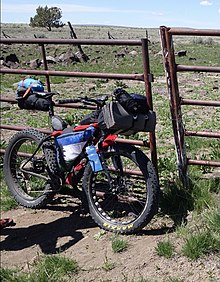
Trail riding is riding outdoors on trails, bridle paths, and forest roads, but not on roads regularly used by motorised traffic. A trail ride can be of any length, including a long distance, multi-day trip. It originated with horse riding, and in North America, the equestrian form is usually called "trail riding," or, less often "hacking." In the UK and Europe, the practice is usually called horse or pony trekking.
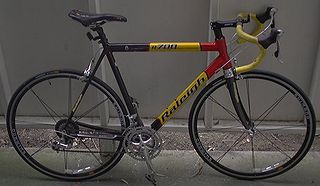
The term road bicycle is used to describe bicycles built for traveling at speed on paved roads. Some sources use the term to mean racing bicycle. Other sources specifically exclude racing bicycles from the definition, using the term to mean a bicycle of a similar style but built more for endurance and less the fast bursts of speed desired in a racing bicycle; as such, they usually have more gear combinations and fewer hi-tech racing features. Certain of these bicycles have been referred to as 'sportive' bicycles to distinguish them from racing bicycles.

A mountain bike (MTB) or mountain bicycle is a bicycle designed for off-road cycling. Mountain bikes share some similarities with other bicycles, but incorporate features designed to enhance durability and performance in rough terrain, which makes them heavier, more complex and less efficient on smooth surfaces. These typically include a suspension fork, large knobby tires, more durable wheels, more powerful brakes, straight, extra wide handlebars to improve balance and comfort over rough terrain, and wide-ratio gearing optimised for topography, application and a frame with a suspension mechanism for the rear wheel. Rear suspension is ubiquitous in heavier-duty bikes and now common even in lighter bikes. Dropper seat posts can be installed to allow the rider to quickly adjust the seat height.

Mountain biking is a sport of riding bicycles off-road, often over rough terrain, usually using specially designed mountain bikes. Mountain bikes share similarities with other bikes but incorporate features designed to enhance durability and performance in rough terrain, such as air or coil-sprung shocks used as suspension, larger and wider wheels and tires, stronger frame materials, and mechanically or hydraulically actuated disc brakes. Mountain biking can generally be broken down into distinct categories: cross country, trail, all mountain, enduro, downhill and freeride.
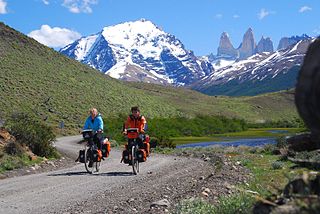
Bicycle touring is the taking of self-contained cycling trips for pleasure, adventure or autonomy rather than sport, commuting or exercise. Bicycle touring can range from single-day trips to extended travels spanning weeks or months. Tours may be planned by the participant or organized by a tourism business, local club or organization, or a charity as a fund-raising venture.

A touring bicycle is a bicycle designed or modified to handle bicycle touring. To make the bikes sufficiently robust, comfortable and capable of carrying heavy loads, special features may include a long wheelbase, frame materials that favor flexibility over rigidity, heavy duty wheels, and multiple mounting points.

Cyclo-cross is a form of bicycle racing. Races typically take place in the autumn and winter, and consist of many laps of a short course featuring pavement, wooded trails, grass, steep hills and obstacles requiring the rider to quickly dismount, carry the bike while navigating the obstruction and remount. Races for senior categories are generally between 40 minutes and an hour long, with the distance varying depending on the ground conditions. The sport is strongest in the traditional road cycling countries such as Belgium, France and the Netherlands.
Hybrid bicycles blend characteristics from more specialized road bikes, touring bikes and mountain bikes. The resulting "hybrid" is a general-purpose bike that can tolerate a wide range of riding conditions and applications. Their stability, comfort and ease of use make them popular with novice cyclists, casual riders, commuters, and children.

The six main types of motorcycles are generally recognized as standard, cruiser, touring, sports, off-road, and dual-purpose. Sport touring is sometimes recognized as a seventh category or integrated with the touring category.
A dual-sport motorcycle is a type of street-legal motorcycle that is designed for both on and off-road use. The terms all-road, on/off-road, and dual-purpose are also used for this class of motorcycles. Dual-sports are equipped with street-legal equipment such as lights, speedometer, mirrors, horn, license plate mounting, and muffler and can, therefore, be registered and licensed.

Bikecentennial '76 was an event consisting of a series of bicycle tours on the TransAmerica Bicycle Trail across the United States in the summer of 1976 in commemoration of the bicentennial of America's Declaration of Independence. The route crossed ten states, 22 national forests, two national parks, and 112 counties between Astoria, Oregon, and Yorktown, Virginia, a distance of about 4,250 miles (6,840 km). The route was chosen to take cyclists through small towns on mostly rural, low-traffic roads.

A BMX bike is a road sport bicycle used for racing or stunt riding. BMX means bicyclemotocross.
The Great Divide Mountain Bike Route (GDMBR) is a 3,083.8 mi (4,962.9 km), off-road bicycle touring route between Jasper, Alberta, Canada and Antelope Wells, New Mexico, USA. Completed in 1997, the GDMBR was developed by Adventure Cycling Association, who continue to maintain highly detailed route maps and a guidebook.
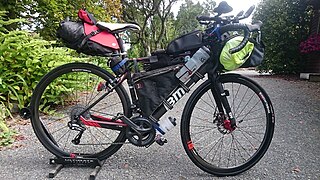
Bikepacking is how a bicycle is packed for bicycle touring. As with backpacking, lightweight packing is a popular topic within bicycle packing. Any kind of bicycle can be used for bikepacking, and specialized touring bicycles often have attachment points from the factory such as low riders and luggage carriers, but most types of bicycles can be equipped with a frame bag, saddle bag, top tube bag and handlebar bag.

Cold-weather biking, cold-weather cycling, or winter biking is the use of a bicycle during months when roads and paths are covered with ice, slush and snow. Cold weather cyclists face a number of challenges in near or below freezing temperatures. Urban commuters on city streets may have to deal with "[s]now, slush, salt, and sand", which can cause rust and damage to metal bike components. Slush and ice can jam derailleurs. Some cyclists may bike differently in winter, by "slow[ing] down on turns and brak[ing] gradually" in icy conditions. Gaining traction on snow and ice-covered roads can be difficult. Winter cyclists may use bikes with front and rear fenders, metal studded winter tires and flashing LED lights. Winter cyclists may wear layers of warm clothes and "ea[r], face, and han[d]" coverings may be used. Specialized winter bikes called fatbikes, which have wide, oversized tires that are typically inflated with low pressure, are used in snow trail riding and winter bike competitions.
The Idaho Hot Springs Mountain Bike Route is an off-road bicycle touring route in central Idaho. Developed by Adventure Cycling Association, the route consists of 518 miles of mostly dirt roads and 227 miles of optional singletrack, with access to more than 50 hot springs.
The TransAmerica Trail or TAT is a 4,253-mile (6,845 km) transcontinental vehicular route, intended as a recreational pathway across the United States using a minimum of paved roads, traveled by dual-sport motorcycles, off-road vehicle, or touring bicycle.

Gravel cycling, gravel biking or gravel grinding is a sport, or a leisure activity, in which participants ride bicycles mostly on gravel roads. Sometimes, specially designed gravel bikes are used; in other cases, any bicycle capable of covering the terrain can be used.
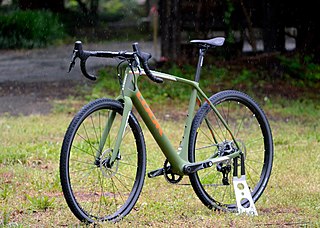
A gravel bicycle is a type of bicycle intended for gravel cycling, including gravel racing. They are also sometimes known as "adventure bicycles", particularly ones intended for harsher off-road terrain.
